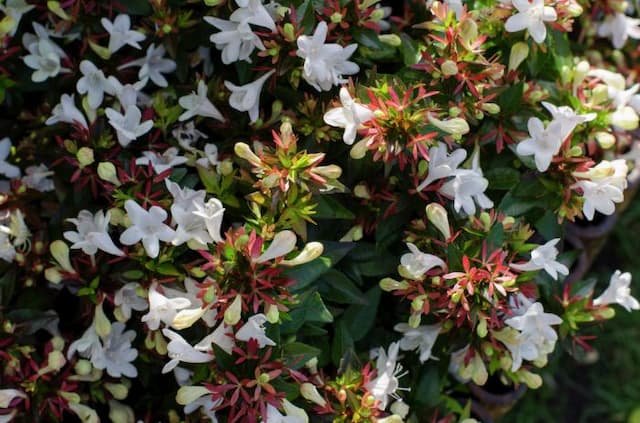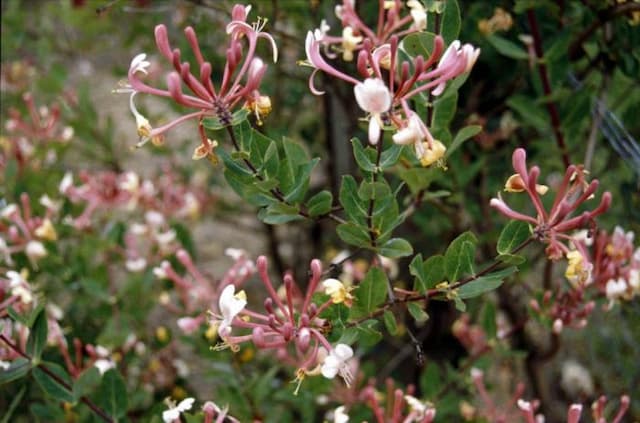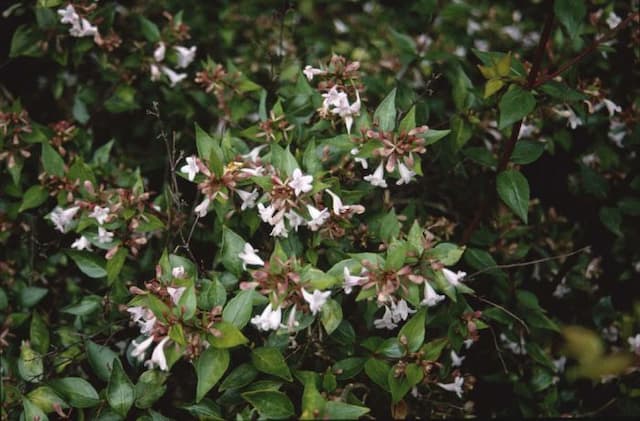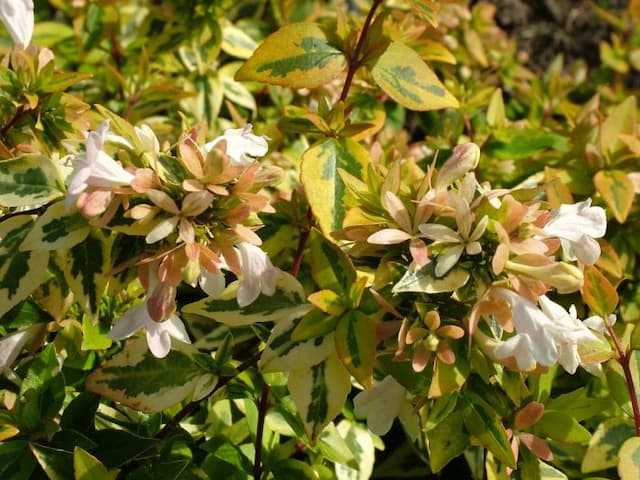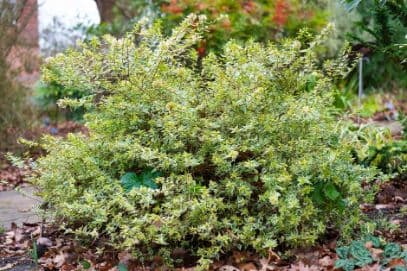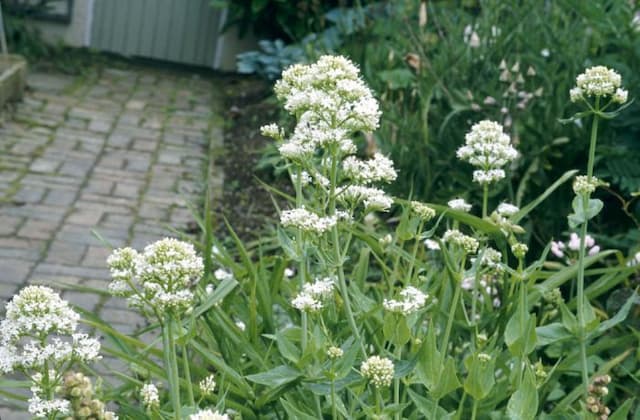Bush Honeysuckle Diervilla × splendens

ABOUT
The plant known as Diervilla × splendens, commonly referred to as simply Diervilla, is a deciduous shrub that presents a lush, bushy appearance. Its foliage is characteristically vibrant, with leaves that can exhibit a range of colors from green in the spring and summer to shades of yellow, orange, and even reddish hues in the fall. The leaves are oval-shaped with pointed tips and have serrated edges, which can give the foliage a slightly textured look. During the blooming period, Diervilla produces clusters of small, tubular flowers. The blossoms are typically yellow and can add a pop of color to the plant's already bright foliage. The flowers often have a trumpet-like shape and are attractive to pollinators, such as bees and butterflies. After flowering, the plant may produce small, inconspicuous fruit that is not particularly ornamental. The overall appearance of Diervilla × splendens is somewhat rounded and spreading, making it a favored choice for gardeners who wish to add a dense, decorative element to their landscapes without concern for the plant's dimensions. With its attractive foliage transitions and charming yellow flowers, the Diervilla provides visual interest throughout multiple seasons.
About this plant
 Names
NamesFamily
Caprifoliaceae.
Synonyms
Showy Bush Honeysuckle, Splendid Bush Honeysuckle.
Common names
Diervilla × splendidens.
 Toxicity
ToxicityTo humans
Diervilla × splendens, commonly known as bush honeysuckle, is not known to be toxic to humans. There is no documented evidence that ingesting any part of this plant leads to poisoning or produces harmful effects in humans. As with any plant, it's always wise to be cautious and avoid ingesting parts of plants that are not typically consumed as food, as individual allergies or reactions can occur.
To pets
Diervilla × splendens, commonly referred to as bush honeysuckle, does not present any known toxicity to pets. It is generally considered a non-toxic plant for pets such as dogs and cats, and ingestion of parts of this plant is unlikely to lead to poisoning or adverse health effects. However, pet owners should always monitor their animals for any unusual behavior or symptoms after ingesting plant material and consult a veterinarian if any concerns arise.
 Characteristics
CharacteristicsLife cycle
Perennials
Foliage type
Deciduous
Color of leaves
Green
Flower color
Yellow
Height
3-4 feet (0.91-1.22 meters)
Spread
3-4 feet (0.91-1.22 meters)
Plant type
Shrub
Hardiness zones
4-7
Native area
North America
Benefits
 General Benefits
General Benefits- Attracts Pollinators: Diervilla × splendens, commonly known as the Bush Honeysuckle, is known to attract bees, butterflies, and other pollinating insects, supporting local ecosystems.
- Drought Tolerance: Once established, it is quite drought-tolerant, making it a suitable choice for xeriscaped gardens or regions with low rainfall.
- Erosion Control: Its root system helps to prevent soil erosion, particularly when planted on slopes or in areas prone to erosion.
- Low Maintenance: This plant typically requires minimal upkeep, making it ideal for gardeners seeking low-maintenance landscaping options.
- Decorative Appeal: The Bush Honeysuckle has attractive yellow flowers and provides visual interest in the landscape from spring through fall.
- Habitat Support: The plant provides shelter and nesting sites for various birds and small wildlife.
- Easy Propagation: It can be easily propagated from cuttings or division, helping gardeners to spread the plant throughout their garden without additional costs.
- Tolerant of Varied Soil Types: It can thrive in a wide range of soil conditions, from clay to loam, making it versatile for different garden settings.
 Medical Properties
Medical PropertiesThis plant is not used for medical purposes.
 Air-purifying Qualities
Air-purifying QualitiesThis plant is not specifically known for air purifying qualities.
 Other Uses
Other Uses- The shrub's dense branching pattern can be used as a privacy screen, effectively blocking undesirable views and creating a sense of seclusion.
- Its hardiness makes Diervilla × splendens suitable for controlling erosion on steep slopes or in areas where vegetation is needed to stabilize the soil.
- With its tolerance for shade, the bush honeysuckle can be planted under trees or in woodland gardens where other ornamentals might struggle.
- Gardeners may use the plant for its attractiveness to pollinators, particularly bees, to improve pollination in vegetable gardens and orchards.
- The plant can be used in noise abatement strategies, where thick plantings can help to dampen traffic noise or other community noise pollution.
- Diervilla × splendens can be incorporated into sensory gardens, where its foliage and fragrant flowers contribute to a stimulating multisensory experience.
- Its tolerance to a range of soil types allows it to be used in urban landscaping projects where soil conditions may be less than ideal.
- The contrasting colors of the foliage, especially in fall, make the bush honeysuckle an attractive choice for seasonal displays in public gardens and parks.
- Landscape designers might use the plant to create habitat corridors for wildlife, offering shelter and food resources in managed landscapes.
- Being a low-maintenance plant that doesn't typically require pesticides or herbicides, the bush honeysuckle can be a sustainable choice for eco-friendly gardening practices.
Interesting Facts
 Feng Shui
Feng ShuiThe Diervilla × splendens, commonly known as Bush Honeysuckle, is not used in Feng Shui practice.
 Zodiac Sign Compitability
Zodiac Sign CompitabilityThe Bush Honeysuckle is not used in astrology practice.
 Plant Symbolism
Plant Symbolism- Resilience: Diervilla × splendens, commonly known as the Bush Honeysuckle, is a hardy plant that can thrive in various conditions, symbolizing the ability to persist and adapt through adversity.
- Growth: Bush Honeysuckle is a fast-growing plant, representing personal or professional growth and the rapid progression of endeavors.
- Attraction: Its flowers can attract butterflies and other pollinators, signifying attraction and magnetism in both personal charm and the allure one might hold in life or relationships.
- Unity: As a hybrid plant, the Bush Honeysuckle can symbolize unity and the bringing together of diverse elements to create something new and beautiful.
 Water
WaterThe Bush Honeysuckle should be watered deeply, allowing the water to reach the root zone. It's best to water the plant once a week, providing about 1 to 1.5 gallons depending on the climate and soil drainage. During hot and dry periods, you might need to water more frequently, monitoring the soil moisture to prevent overwatering. In cooler months, reduce the watering frequency. The goal is to maintain even moisture without letting the plant sit in waterlogged soil.
 Light
LightBush Honeysuckle thrives best in full sun to partial shade. It should be placed in a spot where it receives at least 4 to 6 hours of sunlight daily. However, if you're in a particularly hot climate, some afternoon shade will help prevent scorching.
 Temperature
TemperatureBush Honeysuckle is adaptable to a wide range of temperatures, thriving ideally in temperatures between 60 and 75 degrees Fahrenheit. It can survive minimum temperatures down to around 0 degrees Fahrenheit but may sustain winter damage. The maximum temperature this plant can withstand typically falls around 90 degrees Fahrenheit.
 Pruning
PruningPrune Bush Honeysuckle to maintain its shape and health or to manage its size. It's best to prune in late winter or early spring before new growth starts. Pruning annually or biannually is usually enough, focusing on removing any dead or damaged branches and thinning out as needed for good air circulation.
 Cleaning
CleaningAs needed
 Soil
SoilBush Honeysuckle thrives best in a well-draining, fertile soil mix with added organic matter, such as compost or peat moss. The ideal pH range for Bush Honeysuckle is slightly acidic to neutral, between 6.0 and 7.0.
 Repotting
RepottingBush Honeysuckle does not need frequent repotting and can thrive for years without being moved to a new container, repotting is generally necessary only if the plant has outgrown its current pot or if the soil has become compacted.
 Humidity & Misting
Humidity & MistingBush Honeysuckle is adaptable to various humidity levels but would appreciate a moderate humidity environment, which reflects its natural woodland habitat.
 Suitable locations
Suitable locationsIndoor
Provide bright indirect light for Bush Honeysuckle indoor.
Outdoor
Plant Bush Honeysuckle in a sunny or part-shade spot.
Hardiness zone
4-8 USDA
 Life cycle
Life cycleThe life cycle of the Diervilla × splendens, commonly known as Bush Honeysuckle, begins with seed germination, which occurs in favorable conditions of warmth and moisture in soil. Once germinated, the seedling emerges and develops into a juvenile plant, establishing a root system and sprouting its first leaves. As it enters the vegetative growth stage, the Bush Honeysuckle develops a woody stem and a fuller complement of leaves, preparing for the reproductive phase. In the reproductive stage, typically in early summer, the plant produces clusters of small, tubular yellow flowers that are pollinated by insects, leading to the formation of seeds. After flowering, seeds are dispersed by various means, including wind, water, and animals, contributing to the spread of the plant. The Bush Honeysuckle is a perennial, so it can live for many years, undergoing cycles of dormancy in winter and regrowth in spring.
 Propogation
PropogationPropogation time
Early spring
Propogation: The most popular method of propagation for the Diervilla × splendens, commonly known as the showy bush honeysuckle, is through softwood cuttings. This is typically done in late spring to early summer when new growth is soft and flexible. To propagate, a gardener would cut a 4 to 6 inch (10 to 15 cm) piece of stem that has a few leaves on it, remove the leaves from the lower half of the cutting, and dip the cut end into a rooting hormone to encourage root development. The cutting can then be placed in a pot with well-draining soil mix, keeping it moist and under indirect sunlight until roots have developed, which can take several weeks. After rooting, the new plant can be gradually acclimated to outdoor conditions and then transplanted into the garden.


